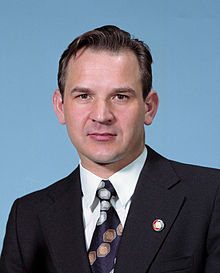Valeri Kubasov
Russian - (RFSA)
Deceased
Date of Birth: Jan. 7, 1935
Date of Death: Feb. 19, 2014
Valeri Nikolayevich Kubasov (Russian: Вале́рий Никола́евич Куба́сов; 7 January 1935 – 19 February 2014) was a Soviet/Russian cosmonaut who flew on two missions in the Soyuz programme as a flight engineer: Soyuz 6 and Soyuz 19 (the Apollo–Soyuz mission), and commanded Soyuz 36 in the Intercosmos programme. On 21 July 1975, the Soyuz 7K-TM module used for ASTP landed in Kazakhstan at 5:51 p.m. and Kubasov was the first to exit the craft. Kubasov performed the first welding experiments in space, along with Georgy Shonin.
Soyuz | Soyuz 6
Russian Federal Space Agency (ROSCOSMOS) | RussiaBaikonur Cosmodrome, Republic of Kazakhstan
Oct. 11, 1969, 11:10 a.m.
Status: Success
Mission:
Soyuz 6 was a joint mission with Soyuz 7 and Soyuz 8 that saw three spacecraft in orbit together at the same time. Soyuz 6 mission was to take high quality photographs of the Soyuz 7 and Soyuz 8 docking but on all three spacecraft the docking system failed. The mission was commanded by Georgi Shonin and Flight Engineer Valeri Kubasov.
Low Earth OrbitSoyuz-U | Soyuz 19
Russian Federal Space Agency (ROSCOSMOS) | RussiaBaikonur Cosmodrome, Republic of Kazakhstan
July 15, 1975, 12:20 p.m.
Status: Success
Mission:
Soyuz 19 was a part of the Apollo-Soyuz Test Project, which was the first joint US-Soviet space flight. The Soviet side of mission began on July 15, 1975, 12:20:00 UTC, launching Commander Alexey Leonov and Flight Engineer Valeri Kubasov into orbit. Two days later, they docked with the Apollo spacecraft. American and Soviet crews visited each other's spacecrafts, performed docking and redocking maneuvers, conducted joint scientific experiments, exchanged flags and gifts. Crews spent more than 44 hours together, and after final parting of the ships Soviet crew spent five more days in orbit. Soyuz 19 returned to Earth with a safe landing on July 21, 1975, 10:50:00 UTC.
Low Earth OrbitSoyuz-U | Soyuz 35
Russian Federal Space Agency (ROSCOSMOS) | RussiaBaikonur Cosmodrome, Republic of Kazakhstan
April 9, 1980, 1:38 p.m.
Status: Success
Mission:
Soyuz 35 was the eighth mission to visit the Salyut 6 space station and carried the EO-4 expedition, which was the fourth long-duration crew for the station. The mission began on April 9, 1980, 13:38:22 UTC, launching Commander Leonid Popov and Research Cosmonaut/Flight Engineer Valery Ryumin into orbit. They docked with the station the next day. During their 186-day stay on the station, EO-4 crew conducted various scientific experiments, some repairs and replacements to the station and were visited by three uncrewed Progress cargo spacecrafts and 4 crewed Soyuz vehicles. Soyuz 35 swapped vehicles with the Soyuz 37 crew, which allowed for a longer stay in orbit. The mission concluded with a safe landing back on Earth on October 11, 1980, 09:49:57 UTC.
Low Earth OrbitSoyuz-U | Soyuz 36
Russian Federal Space Agency (ROSCOSMOS) | RussiaBaikonur Cosmodrome, Republic of Kazakhstan
May 26, 1980, 6:20 p.m.
Status: Success
Mission:
Soyuz 36 was the ninth mission to visit the Salyut 6 space station and carried the EP-5 crew, which visited the long-duration Soyuz 35 resident crew. The mission began on May 26, 1980, 18:20:39 UTC, launching Commander Valery Kubasov and Research Cosmonaut Bertalan Farkas, the first Hungarian cosmonaut, into orbit. They docked with the station the next day. During their 7-day stay on the station, EP-5 crew conducted various scientific experiments, including measuring radiation doses received by the crew. Soyuz 36 swapped vehicles with the resident station crew, and returned in Soyuz 35 spacecraft. The mission concluded with a safe landing back on Earth on June 3, 1980, 15:06 UTC.
Low Earth OrbitThe Roscosmos State Corporation for Space Activities, commonly known as Roscosmos, is the governmental body responsible for the space science program of the Russian Federation and general aerospace research. Soyuz has many launch locations the Russian sites are Baikonur, Plesetsk and Vostochny however Ariane also purchases the vehicle and launches it from French Guiana.
Falcon 9
CSG-3
Space Launch Complex 4E - Vandenberg SFB, CA, USACSG-3 is an Earth observation satellite for the Italian Space Agency, part of a reconnaissance constellation using synthetic aperture radars operatin…
Long March 7A
Shijian 29 A-B
201 - Wenchang Space Launch Site, People's Republic of China2 satellites officially described as for "demonstration of new technologies for spatial targets detection" purposes.
Long March 4B
Tianhui 7
Launch Area 94 (SLS-2 / 603) - Jiuquan Satellite Launch Center, People's Republic of ChinaA satellite officially described as for cartography purposes, details TBD.
Soyuz 2.1b/Fregat-M
AIST-2T 01 & 02
Cosmodrome Site 1S - Vostochny Cosmodrome, Siberia, Russian FederationA pair of Russian optical Earth observation satellites built by the Progress Rocket Space Centre for obtaining stereo images of the Earth's surface, …
Long March 3B/E
Fengyun-4C
Launch Complex 2 (LC-2) - Xichang Satellite Launch Center, People's Republic of ChinaChina's geostationary meteorological satellite program FY-4 (Feng Yun 4) is the second generation of chinese geostationary meteorological satellites.



